- Part I. Research Outline / Introduction / 1. Actual conditions of pregnancy and delivery / 2. Attitude and awareness toward parenting
- Part II. 3. Child-rearing and the relationship of husband and wife / 4. Child-rearing environment (This article)
- Part III. 5. Balancing work and family during pregnancy and child-rearing / 6. QOL during pregnancy/child-caring period
Chapter 3. Child-rearing and the relationship of husband and wife
How much are husbands and wives raising their first child each involved in housework and child-rearing? This survey asks about seven activities: three concerning housework (cleaning, laundry, and cooking: meal preparation/cleanup), and four concerning child-rearing (playing with the child, changing diapers/toilet training, putting the child to sleep, and calming the child down). The difference in the involvement between the husbands and wives is evident: husbands' degree of involvement is lower than that of wives for most of the items. Furthermore, husbands tend to be engaged more in child-rearing rather than in housework.
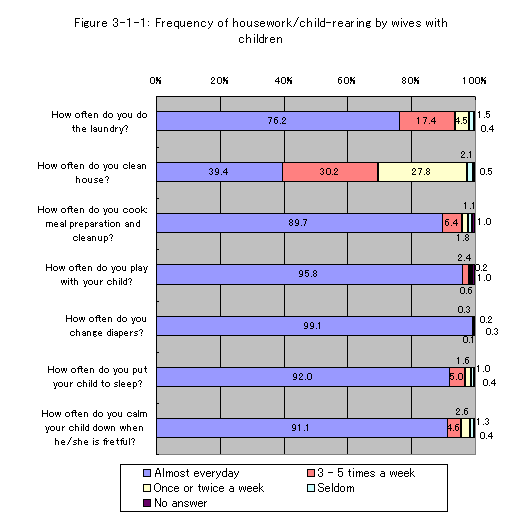
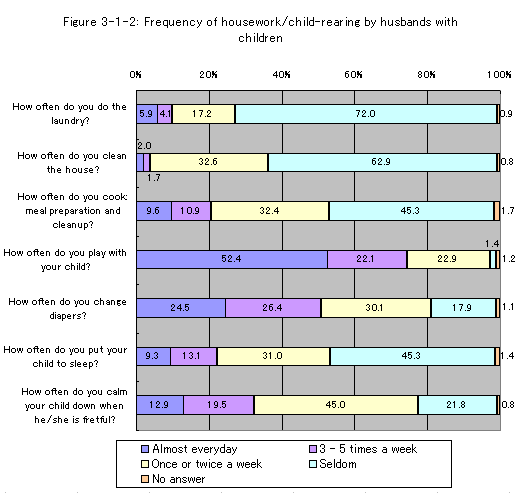
Compared to the husbands with non-working wives, husbands with working wives are more frequently involved in housework/child-rearing. Specifically, 15.7% and 10.2% of the husbands with working wives do the cooking and laundry almost everyday, respectively. In other words, 10?15 % of the husbands with working wives engage in such housework everyday. The percentage of husbands with non-working wives who do housework is less than half of husbands with working wives. The same applies for child-rearing. The percentage of the husbands with non-working wives who are involved in child-rearing everyday is lower.
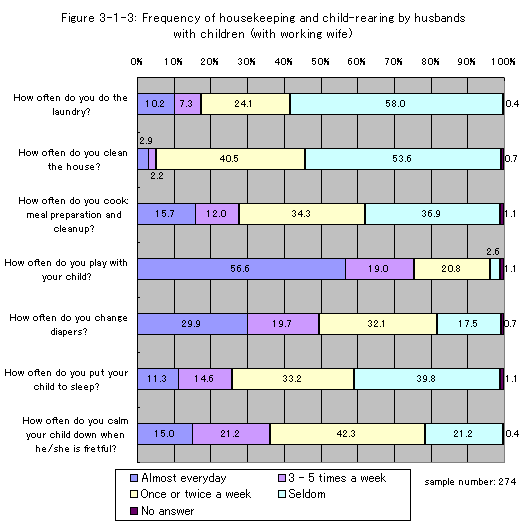
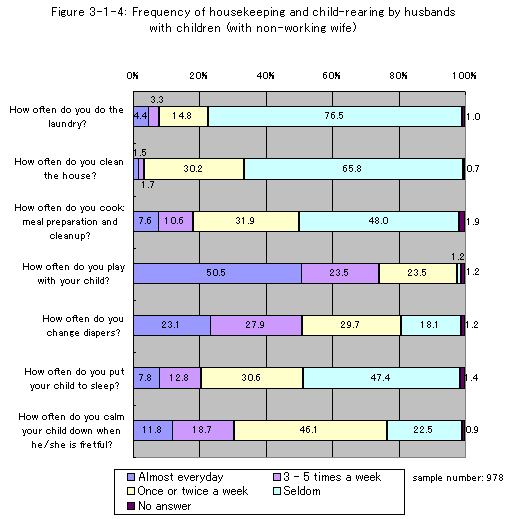
However, more than half of the husbands with working wives rarely do laundry and cleaning, and 36.9% rarely cook. In addition, approximately 20% of the husbands with working wives rarely engage in child-rearing. Wives bear a conspicuously great burden. (The result does not apply to the item "playing with the child".)
Regarding the relationship between the husband and wife during pregnancy and child-rearing, both husbands and wives during pregnancy report high degrees of happiness in their marriage and affection for their spouse. During the childcare period, however, the love of both husbands and wives for their spouse tends to lessen as the child gets older. Particularly, the tendency is the strongest among postpartum wives.
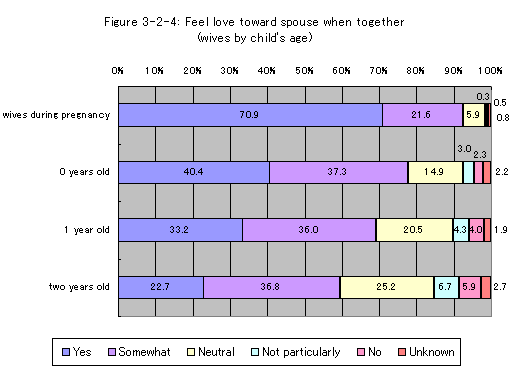
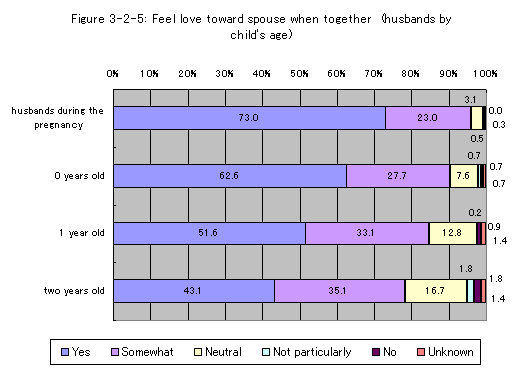
The percentage of wives who answer "Yes" to the question "My husband thanks me for taking care of our child" decreases as the child gets older. One out of four wives with a 2-year-old child responded to the question negatively. The result may be related to the wives' erosion of love for their husbands after childbirth.
The survey asks about ideal and real distribution of roles, which are divided into four categories: parental role; husband/wife role; role as a member of society and working person; and role as an individual adult, so that the total sum of these roles is 100 percent. It is the husbands and wives raising children who show the greatest gap between the ideal and reality. The gap is much larger than that of husbands and wives during pregnancy.
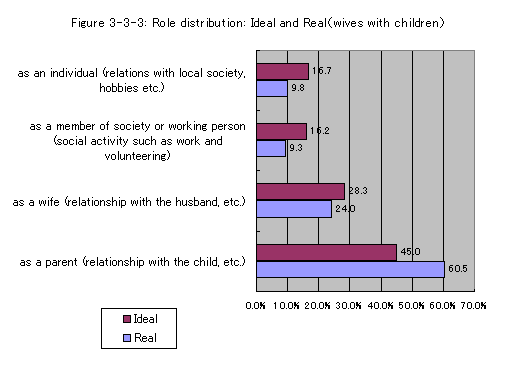
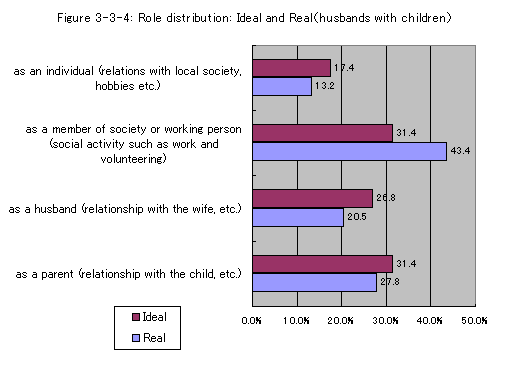
Among husbands with a wife and child, their role as a member of society and working person is given a lower ideal distribution than in reality, while their roles as parent, husband, and individual is given a greater ideal distribution than in reality. It seems to indicate that these husbands are busy working and not able to balance work and family life. (Junko Takaoka)
Chapter 4. Child-rearing environmentThe survey examines the availability of practical support environments for pregnancy, childbirth and child-rearing in the neighborhood. More than half of the wives during the pregnancy answer that there is no private obstetrician/gynecologist's hospital and gynecology or maternity clinic in the neighborhood (within 20 minutes on foot).
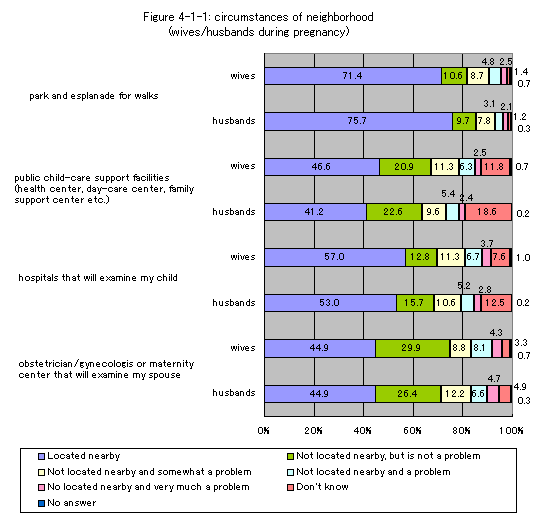
On the other hand, 70% of the wives with children respond that there are parks and walking trails in the neighborhood (within 20 minutes on foot), and approximately 50% answer that there are nearby child-rearing support facilities. In addition, 68.4% of the wives with children mentioned that they have private pediatrician or pediatric clinic. Obviously, the percentage of the wives with children is higher than that of the wives during the pregnancy. It can be said that wives tried to find these facilities under the pressure of necessity or moved to a more convenient environment for child-rearing.
Regarding day-care, one out of five wives who have a 0-2 year old child uses day-care or a childcare service regularly.
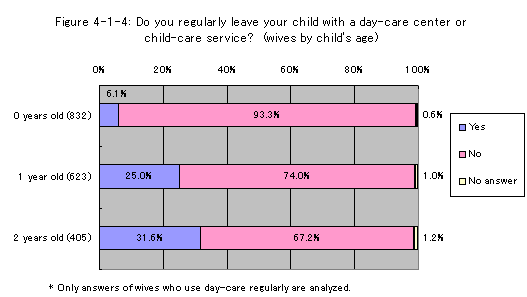
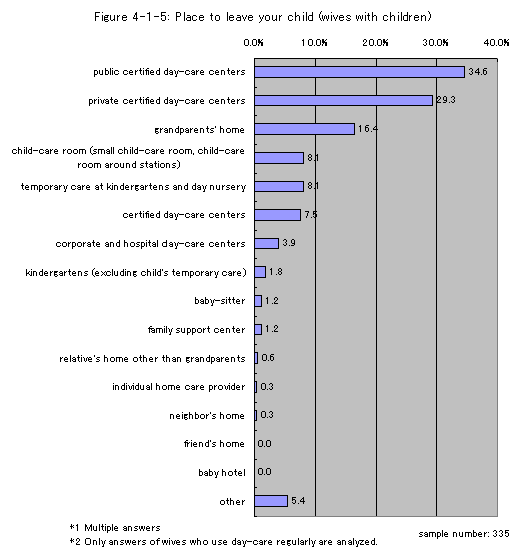
Figure 4-1-5 shows the specific type used by wives with a child. The survey asks the wives who use day-care regularly to choose all of types they use (multiple answers). Among 16 items, the top three are: a licensed public day-care center (34.6%); a licensed private day-care center (29.3%); and the grandparents' house (16.4%). Regarding the degree to which they can trust the caretakers or services of the day-care center where the child spends most of the time, 95.5% of the respondents answer "yes" or "mostly yes" to the question "Do you think your child receives adequate daycare?" In addition, more than 90% of mothers think their child is attached to the facility caretakers. The result demonstrates the mothers' high trust in caretakers. On the contrary, the percentage of the mothers who think they are trusted by the caretaker is a little lower (71.4%).
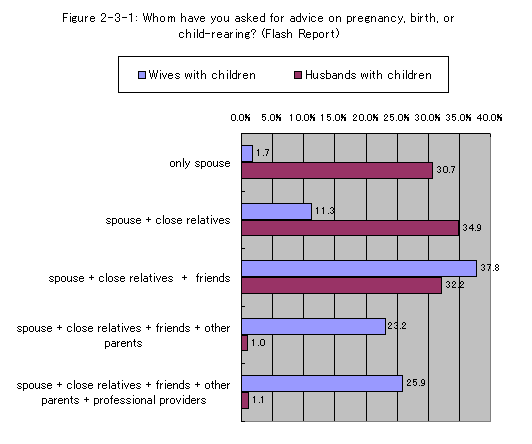
Figure 2-3-1 (Flash report) shows the answers of the husbands/wives with children to the question "Who have you consulted about pregnancy, childbirth, and child-rearing?" Compared with husbands, wives have wider social networks for child-rearing. The wider the social network, the more satisfaction and sense of growth and the less burden and anxiety they have. Based on the child's age bracket, their social life within the community expands through the child as the child gets older. The percentages of mothers with a 0-year-old, 1-year-old, and 2-year-old child who do not have anyone whom they can ask to take care of their child decrease as the child gets older (58.4%, 56.8%, and 48.1% respectively).
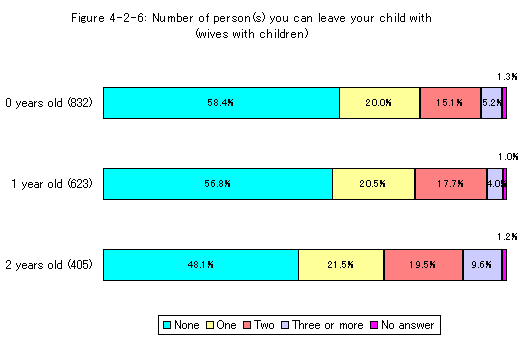
Moreover, the percentage of mothers who answer "yes" to the question "There are three or more people who care about my child" increases as the child gets older. It is assumed that the younger the child, the less the mothers make social contact through child-rearing. (Junko Takaoka)














